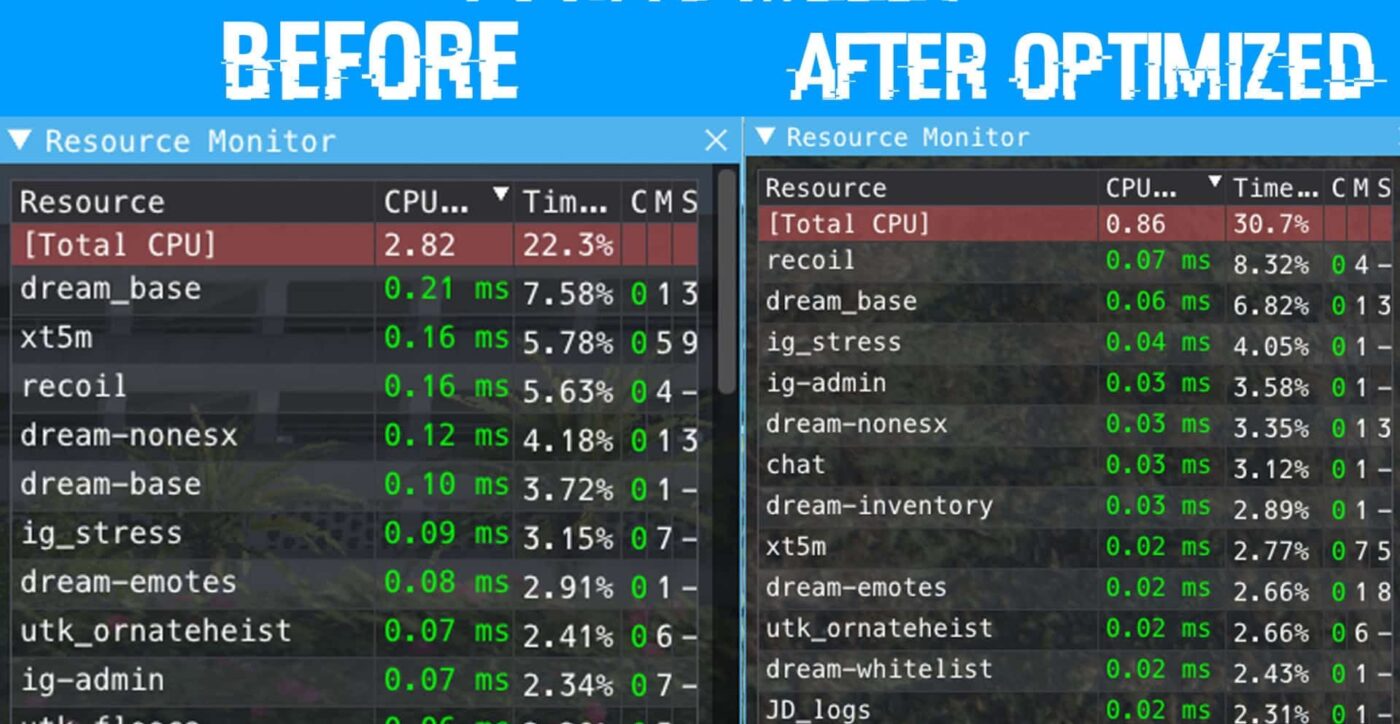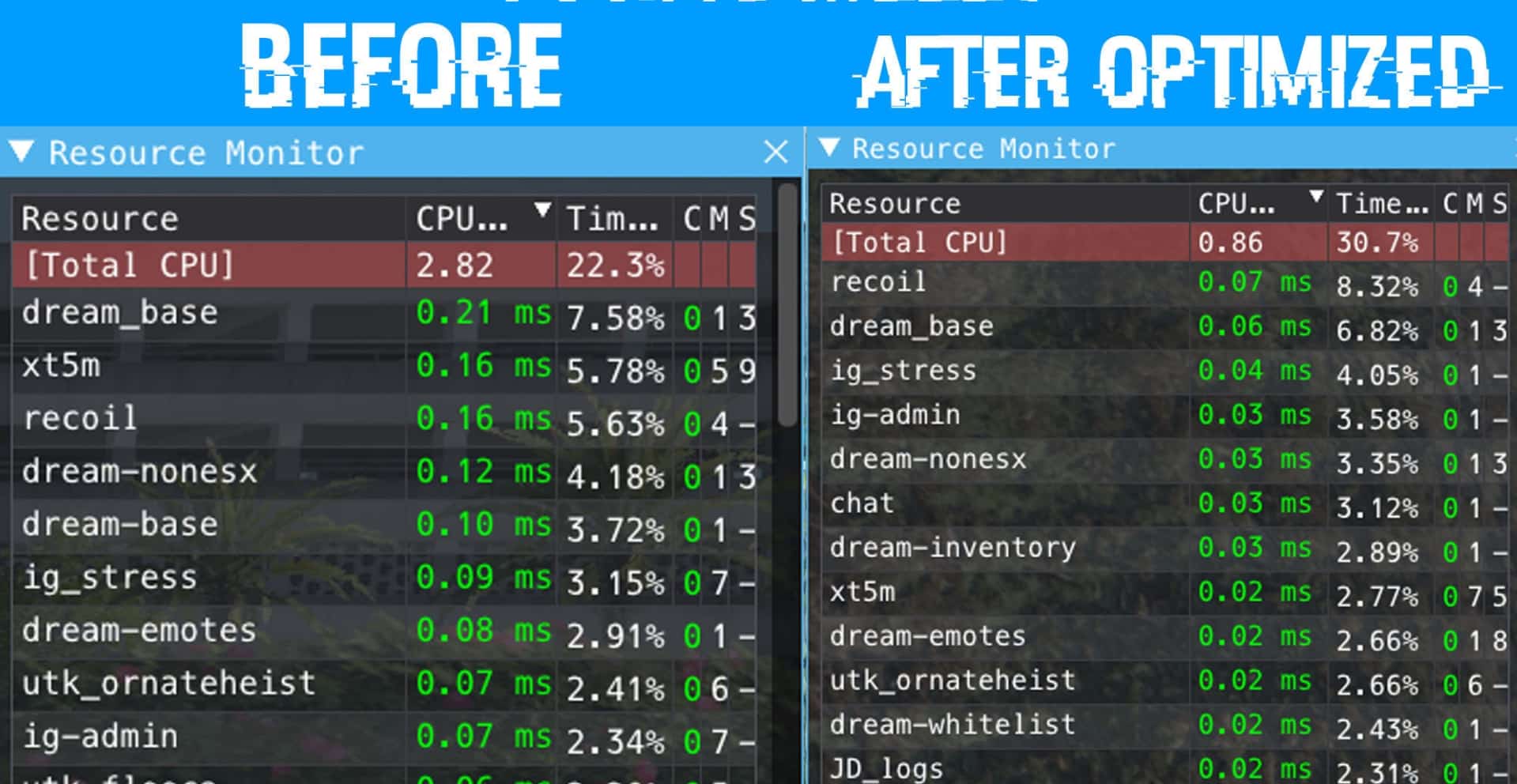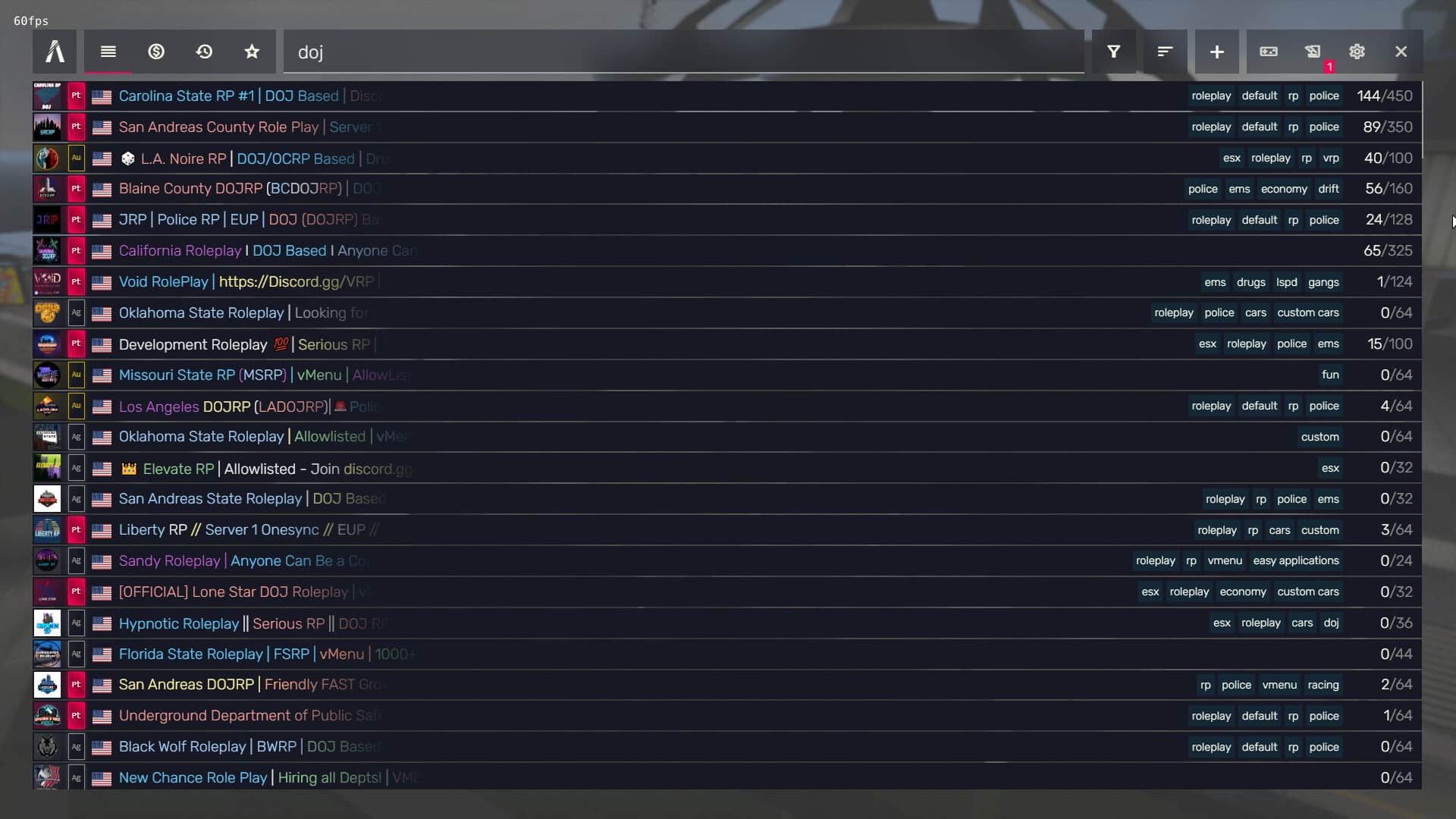Boost FiveM: How To Optimize Loading Times
Optimizing FiveM server loading times is crucial for enhancing player experience and ensuring smooth gameplay. As a multiplayer modification framework for Grand Theft Auto V, FiveM allows users to create custom servers with unique game modes and features. However, long loading times can deter players and diminish the overall appeal of a server. To address this issue, server administrators can implement various strategies, including optimizing resource management, streamlining scripts, and utilizing efficient server configurations. By focusing on these key areas, server owners can significantly reduce loading times, improve performance, and create a more enjoyable environment for players.
What are some effective strategies to optimize FiveM server loading times and improve player experience?
Strategies to Optimize Resource Loading in FiveM Servers
NEW: Use our Script Optimizer here
Optimizing resource loading times in FiveM servers is crucial for enhancing the overall gaming experience. When players join a server, they expect a seamless transition into the game world, and long loading times can lead to frustration and a decline in player retention. Therefore, implementing effective strategies to streamline resource loading is essential. One of the first steps in optimizing loading times is to minimize the number of resources that need to be loaded at the start. This can be achieved by carefully selecting which scripts, models, and textures are essential for the initial gameplay experience. By prioritizing core resources and deferring the loading of non-essential assets, server administrators can significantly reduce the initial load time.
In addition to minimizing resources, it is also important to optimize the size of the assets being loaded. Large textures and models can slow down loading times considerably. To address this, server owners should consider compressing textures and using lower polygon models where possible. Tools such as texture compression software can help reduce file sizes without sacrificing too much quality. Furthermore, utilizing formats that are optimized for performance, such as .dds for textures, can also contribute to faster loading times. Transitioning to more efficient asset formats not only improves loading speeds but also enhances the overall performance of the server.
Another effective strategy involves organizing resources in a logical manner. By structuring resource folders and files systematically, server administrators can ensure that the game engine accesses them more efficiently. For instance, grouping similar assets together can reduce the time it takes for the server to locate and load them. Additionally, using a resource manifest to define dependencies can help the server load resources in the correct order, further streamlining the process. This organization not only aids in loading times but also makes it easier for developers to manage and update resources as needed.
Moreover, leveraging the power of streaming can significantly enhance loading efficiency. FiveM supports streaming, which allows certain resources to be loaded on demand rather than all at once. By implementing streaming for larger assets, such as vehicles or maps, server owners can ensure that players only load what they need at any given moment. This approach not only reduces initial loading times but also minimizes memory usage during gameplay, leading to a smoother experience overall. To effectively implement streaming, it is essential to identify which resources can be streamed and to configure the server settings accordingly.
Furthermore, regular maintenance and updates play a vital role in optimizing resource loading. As new updates are released for FiveM, it is important to keep the server and its resources up to date. Outdated scripts or assets can lead to compatibility issues and longer loading times. By routinely reviewing and updating resources, server administrators can ensure that they are utilizing the latest optimizations and improvements available. Additionally, removing unused or redundant resources can help streamline the loading process, as the server will have fewer files to sift through.
In conclusion, optimizing resource loading times in FiveM servers requires a multifaceted approach. By minimizing the number of resources loaded at startup, compressing asset sizes, organizing files logically, leveraging streaming, and maintaining up-to-date resources, server administrators can create a more efficient and enjoyable gaming experience. Implementing these strategies not only enhances loading times but also contributes to the overall performance and stability of the server, ultimately leading to higher player satisfaction and retention.
Things That Lead to Annoying Loading Delays in FiveM
When it comes to enjoying a seamless gaming experience in FiveM, loading times can significantly impact player satisfaction. Understanding the factors that contribute to annoying loading delays is essential for server administrators and players alike:
- Large Resource Files: Large textures, models, and scripts increase loading times.
- High Player Count: More players strain server resources, causing slower loading.
- Complex or Poorly Optimized Scripts: Inefficient scripts can lead to significant lag.
- Server Location: Servers far from players result in increased latency and delays.
- Server Configuration: Misconfigured settings can create bottlenecks.
- Internet Connection Quality: Slow or unstable connections affect loading speeds.
- Unnecessary Resources: Outdated or unused files can clutter the loading process.
To ensure smooth gameplay in FiveM, it’s crucial to address factors causing loading delays. These include optimizing resource file sizes, managing player counts, refining scripts, choosing appropriate server locations, configuring server settings properly, ensuring stable internet connections, and removing unnecessary resources. By focusing on these areas, server administrators can improve loading times and enhance overall player experience.
Framework Adjustments to Enhance FiveM Server Performance
- Optimize Hardware: Upgrade CPU, increase RAM, and use SSDs for faster data retrieval.
- Adjust Server Settings: Balance the tick rate for smoother gameplay and remove unnecessary scripts and resources.
- Improve Resource Management: Prioritize essential resources and use streaming techniques to reduce initial loading times.
- Implement Caching: Use caching to store frequently accessed data, decreasing loading times for returning players.
- Optimize the Database: Structure the database efficiently and clean up unnecessary data for faster access.
- Keep Software Updated: Regularly update server software to benefit from performance improvements and bug fixes.
Enhancing FiveM server performance involves upgrading hardware, fine-tuning settings, prioritizing essential resources, using caching, optimizing the database, and keeping the software updated. These framework adjustments can significantly improve loading times and overall server stability, providing players with a smoother and more enjoyable gaming experience.
Choosing the Right Server Host for Faster FiveM Loading
When it comes to optimizing FiveM server loading times, one of the most critical decisions you will make is choosing the right server host. The server host you select can significantly impact the performance and speed of your FiveM server, ultimately affecting the gaming experience for you and your players. Therefore, it is essential to consider several factors that contribute to faster loading times.
Click here to read our FiveM Server Host Comparison
First and foremost, the geographical location of the server host plays a vital role in determining latency. A server that is physically closer to your player base will generally provide lower ping times, resulting in quicker loading and smoother gameplay. For instance, if most of your players are located in Europe, opting for a server host with data centers in that region can lead to improved performance. This geographical consideration is crucial because high latency can lead to delays in loading assets, which can frustrate players and diminish their overall experience.
In addition to location, the type of server you choose is equally important. Dedicated servers often outperform shared hosting options, as they provide exclusive resources to your FiveM server. With dedicated hosting, you won’t have to compete with other users for bandwidth or processing power, which can lead to faster loading times. Furthermore, dedicated servers allow for greater customization, enabling you to optimize settings specifically for FiveM, which can further enhance performance.
Another factor to consider is the hardware specifications of the server. When selecting a host, look for servers equipped with high-performance CPUs and ample RAM. A powerful CPU can handle more simultaneous connections and processes, while sufficient RAM ensures that your server can load assets quickly without lag. Additionally, consider the storage type; SSDs (Solid State Drives) are significantly faster than traditional HDDs (Hard Disk Drives) and can drastically reduce loading times. Therefore, opting for a host that utilizes SSDs can provide a noticeable improvement in performance.
Moreover, the bandwidth offered by your server host is crucial for maintaining a smooth gaming experience. Higher bandwidth allows for more data to be transferred simultaneously, which is particularly important during peak times when many players are online. If your server host provides limited bandwidth, you may experience slow loading times and lag, especially when multiple players are trying to connect or when large assets are being loaded. Therefore, it is advisable to choose a host that offers generous bandwidth limits to accommodate your player base.
Additionally, consider the level of customer support provided by the server host. In the event of technical issues or performance problems, having access to responsive and knowledgeable support can make a significant difference. A host that offers 24/7 support can help you quickly resolve any issues that may arise, ensuring that your server remains operational and efficient.
Click here to read our FiveM Server Host Comparison
Finally, it is beneficial to read reviews and gather feedback from other FiveM server administrators. Their experiences can provide valuable insights into the performance and reliability of various hosting providers. By taking the time to research and compare different options, you can make an informed decision that will lead to faster loading times and an overall better gaming experience for your players.
In conclusion, choosing the right server host is a fundamental step in optimizing FiveM server loading times. By considering factors such as geographical location, server type, hardware specifications, bandwidth, customer support, and user reviews, you can select a host that will enhance your server’s performance and provide a seamless experience for all players.
Don’t Spam your Server with Mods
When managing a server, it’s crucial to maintain optimal performance and stability by avoiding the temptation to spam it with an excessive number of mods. Instead of cluttering the server with numerous add-ons, focus on utilizing only the essential resources that genuinely enhance the user experience. For instance, consider merging similar car models or features to streamline your mod collection. This not only reduces the server’s load but also helps maintain a cohesive gameplay environment. By being selective and intentional with your mod choices, you can create a more enjoyable and efficient experience for all players while ensuring the server runs smoothly.
Optimize FiveM Server Loading Times with Efficient Resource Management
Optimizing FiveM server loading times is crucial for enhancing the gaming experience, and one of the most effective ways to achieve this is through efficient resource management. When players connect to a server, they expect quick loading times and smooth gameplay. However, various factors can contribute to delays, and understanding how to manage resources effectively can make a significant difference.
To begin with, it is essential to assess the resources currently in use on your server. This includes scripts, assets, and plugins that may be consuming unnecessary bandwidth or processing power. By conducting a thorough audit of these resources, you can identify any that are redundant or outdated. Removing or updating these elements can lead to a more streamlined server environment, which in turn reduces loading times for players.
In addition to auditing resources, optimizing the size of your assets is another critical step. Large textures, models, and audio files can significantly slow down loading times. By compressing these files or using lower-resolution alternatives where possible, you can decrease the amount of data that needs to be loaded when a player connects. This not only speeds up the loading process but also helps in reducing the overall server load, allowing for a smoother experience for all players.
Moreover, it is beneficial to implement a resource streaming system. This approach allows the server to load only the necessary resources as players enter specific areas or interact with certain elements. By utilizing this method, you can minimize the initial load time, as players will not have to wait for all resources to load at once. Instead, they will experience a gradual loading process that feels more natural and less disruptive.
Another important aspect of resource management is the organization of your server files. Keeping your scripts and assets well-organized can help in quickly identifying and resolving issues that may arise. A clean directory structure not only aids in troubleshooting but also enhances the server’s performance. When files are organized logically, the server can access them more efficiently, which contributes to faster loading times.
Furthermore, consider the use of server-side optimizations. This includes adjusting server settings to allocate more resources to critical processes. For instance, increasing the server’s tick rate can improve performance, allowing for quicker responses to player actions. However, it is essential to find a balance, as overloading the server can lead to other performance issues. Monitoring server performance regularly can help you make informed decisions about resource allocation.
Lastly, community feedback plays a vital role in optimizing server loading times. Engaging with players and encouraging them to report any lag or loading issues can provide valuable insights into areas that require improvement. By addressing these concerns promptly, you can enhance the overall experience for your player base, fostering a more enjoyable gaming environment.
In conclusion, optimizing FiveM server loading times through efficient resource management involves a multifaceted approach. By auditing resources, optimizing asset sizes, implementing resource streaming, organizing files, adjusting server settings, and actively seeking community feedback, you can significantly improve loading times. These strategies not only enhance the player experience but also contribute to the long-term success of your server. As you implement these changes, you will likely notice a marked improvement in both performance and player satisfaction, creating a more engaging and enjoyable gaming experience for everyone involved.
Optimizing Resources with our AI Tool
In FiveM, server loading times can significantly impact the user experience. Players expect quick access to their favorite servers, and any delays can lead to frustration and a decline in player retention. To address this challenge, optimizing resources is essential, and leveraging an AI tool can be a game-changer in this process. By utilizing advanced algorithms and data analysis, an AI tool can help streamline server performance, ensuring that loading times are minimized and efficiency is maximized.
One of the primary ways an AI tool can optimize resources is through intelligent resource allocation. By analyzing server performance metrics in real-time, the AI can identify which resources are being underutilized or overburdened. For instance, if certain scripts or assets are consuming excessive memory or processing power, the AI can recommend adjustments or even automate the redistribution of resources. This dynamic allocation not only enhances performance but also ensures that the server runs smoothly, even during peak times when player activity is at its highest.
NEW: Use our Script Optimizer here
Moreover, the AI tool can assist in identifying and eliminating bottlenecks that may be causing delays in loading times. By examining the various components of the server, such as database queries, script execution times, and asset loading sequences, the AI can pinpoint specific areas that require optimization. For example, if a particular script is consistently slowing down the loading process, the AI can suggest code improvements or alternative methods to achieve the same functionality more efficiently. This targeted approach allows server administrators to focus their efforts on the most critical issues, leading to quicker resolutions and improved overall performance.
In addition to real-time analysis, the AI tool can also provide predictive insights based on historical data. By examining past server performance trends, the AI can forecast potential issues before they arise. This proactive approach enables server administrators to implement changes or upgrades in advance, preventing slowdowns and ensuring a seamless experience for players. For instance, if the AI detects a pattern of increased player activity during certain times of the day, it can recommend scaling up server resources during those peak hours to accommodate the influx of users.
Furthermore, the AI tool can enhance the loading process by optimizing asset management. In many cases, large files or numerous assets can significantly slow down loading times. The AI can analyze which assets are frequently used and which are not, allowing administrators to prioritize the loading of essential files while deferring less critical ones. This selective loading strategy not only speeds up the initial access to the server but also reduces the overall strain on server resources.
NEW: Use our Script Optimizer here
Finally, integrating an AI tool into the optimization process fosters a culture of continuous improvement. As the AI learns from ongoing server performance, it can adapt its recommendations and strategies over time. This iterative process ensures that the server remains responsive to changing player needs and technological advancements, ultimately leading to a more enjoyable gaming experience.
In conclusion, optimizing FiveM server loading times is crucial for maintaining player engagement and satisfaction. By utilizing an AI tool to intelligently allocate resources, identify bottlenecks, provide predictive insights, manage assets effectively, and promote continuous improvement, server administrators can significantly enhance performance. As a result, players will enjoy faster loading times and a smoother gaming experience, fostering a thriving community around the server.
How To Optimize Scripts
Optimizing FiveM server scripts is crucial for ensuring smooth gameplay. This guide outlines steps to enhance performance by identifying bottlenecks, optimizing both server-side and client-side scripts, and utilizing performance tools.
- Identify Performance Bottlenecks: Use FiveM’s built-in tools like the profiler and Resource Monitor (Resmon) to detect scripts consuming excessive CPU or memory.
- Optimize Server-Side Scripts:
- Reduce resource intensity by limiting heavy operations.
- Optimize database queries using asynchronous calls to prevent blocking the main thread.
- Optimize Client-Side Scripts:
- Efficiently handle events to reduce unnecessary processing.
- Minimize frame-time operations by reducing the frequency of checks.
- Utilize Performance Optimization Tools:
- Tools like TxAdmin and keeping FiveM artifacts updated are essential for ongoing optimization.
- Additional Tips:
- Use vector operations for distance calculations instead of native functions for better performance.
- Refactor loops to spread out checks and use events to handle actions instead of continuous condition checks.





